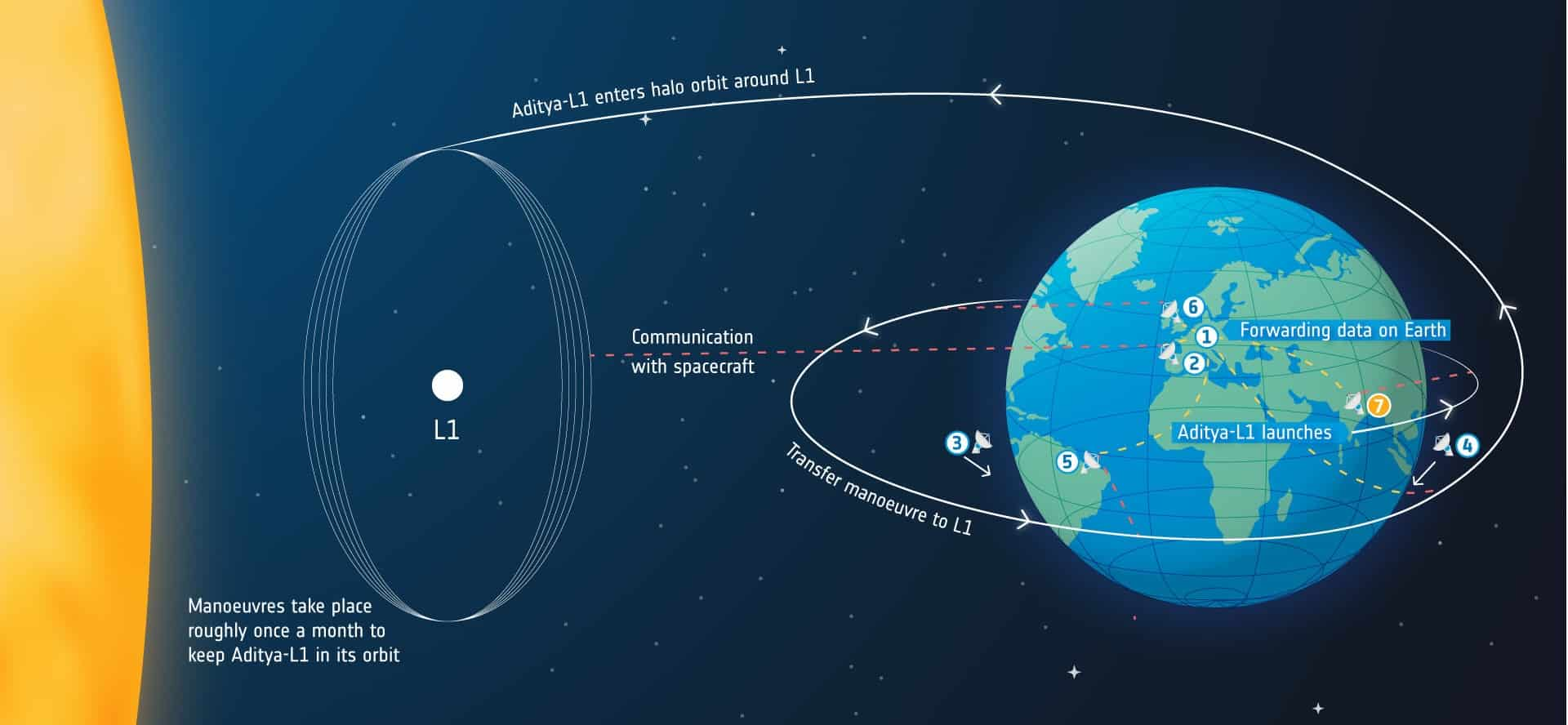India’s space endeavors have reached new heights with each passing mission. After the successful Chandrayaan-3 mission, the Indian Space Research Organisation (ISRO) is gearing up for its next celestial venture – the Aditya-L1 mission, aimed at studying the Sun. In this comprehensive article, we’ll delve into the details of Aditya-L1, its objectives, the significance of studying the Sun, and why this mission holds a special place in India’s space exploration journey.
Chapter One: Understanding Aditya-L1
Aditya-L1, set to launch on September 2, 2023, is a mission that will undoubtedly carve a significant mark in India’s space history. But what exactly is Aditya-L1? Let’s break it down in simple terms.
Aditya – The Sun
“Aditya” in the mission’s name refers to our very own star, the Sun. It’s the primary focus of this mission, as Aditya-L1 aims to gather invaluable insights about the Sun’s behavior and its impact on our planet.
L1 – Lagrange Point
The “L1” part of Aditya-L1 stands for Lagrange Point. During our school days, many of us grappled with Newton’s laws of gravity. Newton’s third law, “For every action, there is an equal and opposite reaction,” holds true in space as well. Both the Earth and the Sun exert gravitational forces on each other, creating a sort of cosmic tug of war. Among these gravitational interactions, five unique points exist, denoted as L1, L2, L3, L4, and L5.
Lagrange points are special because they mark places in space where the gravitational forces between two large bodies, like the Earth and the Sun, balance each other out. These points are chosen for space missions because they offer unique advantages.
For instance, the L2 point hosts NASA’s James Webb Space Telescope, which captures breathtaking images of our universe. At the L1 point, where Aditya-L1 will be positioned, the gravitational pull of the Earth and the Sun will cancel each other out, making it an ideal vantage point for observing the Sun.
Aditya-L1’s Objectives
Aditya-L1 has a dual mission: to observe the Sun and monitor the L1 point itself. To achieve this, the mission is equipped with seven payloads, each with specific functions related to solar observation and L1 point monitoring. The details of these payloads will be explored in a future article.
Chapter Two: Why Study the Sun?
The Sun is an essential component of our solar system, and its influence extends far beyond its radiant warmth. Studying the Sun is of paramount importance for several reasons:
1. Understanding the Solar Corona
The solar corona is the Sun’s outermost layer, visible during solar eclipses as a glowing border. This layer presents a fascinating mystery: while logic suggests that the temperature should decrease with distance from the Sun’s core, the corona’s temperature ranges from 1 to 3 million degrees Celsius, significantly hotter than the Sun’s surface. This coronal heating problem remains unsolved and is a subject of intense study. Aditya-L1 aims to shed light on this enigma.
2. Predicting Solar Storms
Solar storms, characterized by intense bursts of energy and particles from the Sun, can have a profound impact on Earth. While minor solar storms occur frequently, a major solar storm, like the historic Carrington Event in 1859, can disrupt our technology-dependent world. Studying the Sun helps us predict these solar storms, enabling us to prepare and mitigate their effects.
3. Understanding Space Weather
Just as we monitor Earth’s weather for safe navigation, space missions require knowledge of space weather. Solar activities, such as coronal mass ejections (CMEs), solar flares, and ionized plasma, can affect spacecraft, satellites, and even power grids on Earth. By comprehending space weather, we can plan and execute space missions more effectively and safely.
Chapter Three: The Significance of Aditya-L1
Aditya-L1 holds immense significance for India and the global scientific community. Here’s why this mission is a pivotal step in our space exploration journey:
1. India’s First Sun-Focused Mission
Aditya-L1 marks India’s maiden endeavor to study the Sun in detail. While other countries, including the United States, the European Space Agency (ESA), China, Russia, Germany, the UK, and Japan, have launched their own solar missions, India’s foray into this domain demonstrates its commitment to advancing space science.
2. Key Player in Solar Observation
Solar observation is integral to understanding climate change and space weather, which will significantly impact India in the future. With Aditya-L1, India will join an elite club of nations actively contributing to solar research. This mission reaffirms India’s position as a formidable player in space exploration.
3. Advancing Scientific Knowledge
Aditya-L1’s objectives encompass studying the Sun’s behavior, monitoring the solar corona, and predicting solar storms. These endeavors contribute to our scientific understanding of the Sun-Earth relationship and pave the way for improved space weather predictions and climate change studies.
4. Budget Efficiency and Excellence
Aditya-L1 showcases ISRO’s remarkable ability to accomplish ambitious missions on a relatively modest budget. With a total estimated cost of around 400 crores, this mission exemplifies India’s efficient and cost-effective approach to space exploration.
5. Long-Term Observation
Unlike missions with shorter durations, Aditya-L1 is designed to remain active for five years at the L1 point. This extended observation period allows for comprehensive data collection and analysis, ensuring that we gain valuable insights into the Sun’s behavior over time.
6. Global Cooperation
Aditya-L1 won’t be alone at the L1 point; it will share this unique vantage point with the European Space Agency’s Solar Heliospheric Observatory (SOHO) satellite. This cooperation exemplifies the collaborative nature of space exploration and knowledge-sharing on a global scale.
Chapter Four: Concluding Thoughts
In the grand tapestry of space exploration, Aditya-L1 emerges as a bright thread, weaving India’s legacy in the cosmos. As this mission prepares to launch, it symbolizes India’s commitment to scientific advancement, budget efficiency, and global cooperation.
Studying the Sun is not just about understanding a celestial body; it’s about comprehending our own place in the universe and our dependence on this blazing star. Aditya-L1’s journey to the L1 point promises to unveil secrets of the Sun’s corona, enhance our ability to predict solar storms, and empower us with space weather knowledge.
As we eagerly anticipate Aditya-L1’s mission, let’s celebrate India’s contributions to space science and look forward to the new horizons of knowledge this mission will unveil. Feel free to share your best wishes for ISRO and Aditya-L1 in the comments section below. Together, we’re reaching for the stars.
Aditya-L1, India’s ambitious solar mission, is poised to explore the Sun like never before. This article delves into the mission’s objectives, the importance of studying the Sun, and why Aditya












